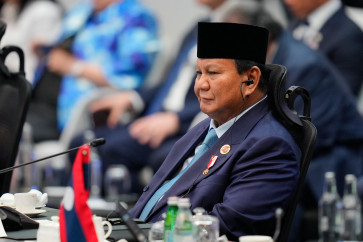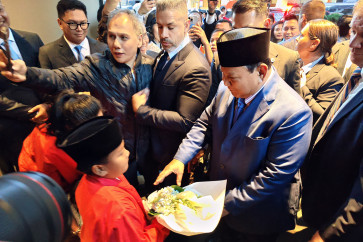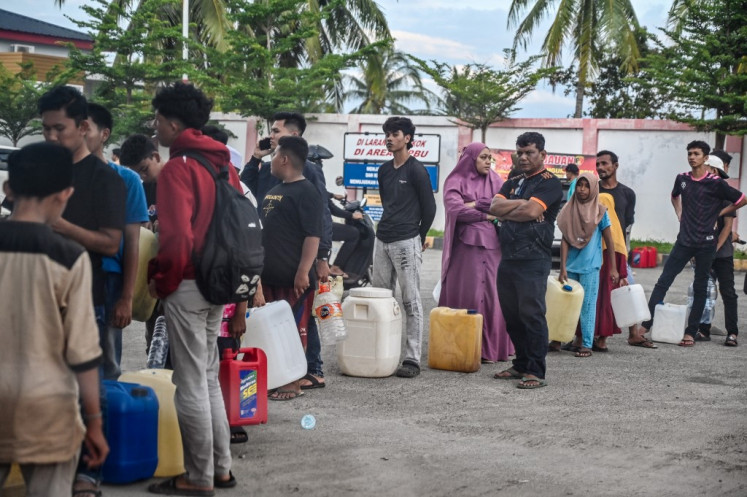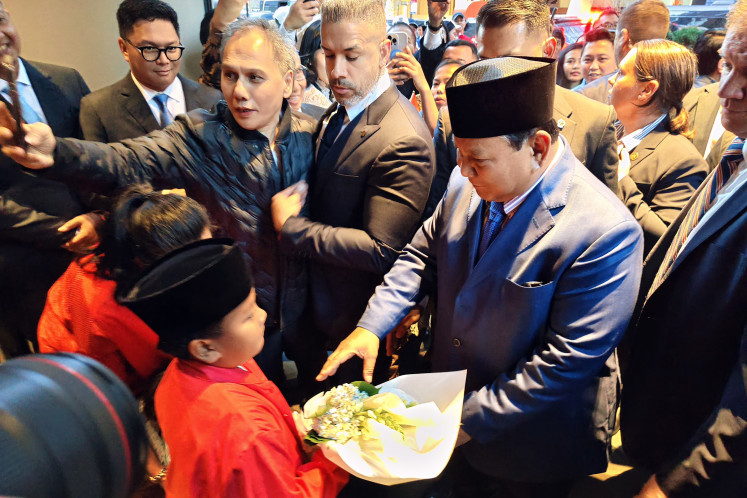Popular Reads
Top Results
Can't find what you're looking for?
View all search resultsPopular Reads
Top Results
Can't find what you're looking for?
View all search resultsLocals help dolphins return to the wild
Locals living near the Dolphin Rehabilitation Center in Kemujan, Karimun Jawa, are lending their support to the center’s team, who aim to return to the wild dolphins accidentally caught by fishermen or used in the entertainment industry, by getting involved with their programs
Change text size
Gift Premium Articles
to Anyone
L
ocals living near the Dolphin Rehabilitation Center in Kemujan, Karimun Jawa, are lending their support to the center’s team, who aim to return to the wild dolphins accidentally caught by fishermen or used in the entertainment industry, by getting involved with their programs.
Beneath the waves: A small pod of wild dolphins play in the open ocean. Dolphins are highly social creatures and have recently been declared by scientists as the world’s second most intelligent creatures after humans. Courtesy of Pete Zuccarini
The center is the first permanent facility in the world to rehabilitate and release dolphins back into the wild (see last week’s The Jakarta Post article “Caught in net of delays”) and was set up to help dolphins illegally captured in the area readapt again to their natural environment.
The initiative comes under the jurisdiction of the Directorate General of Forest Protection and Nature Conservation of the ministry of forestry (PHPA) and is run by the Jakarta Animal Aid Network (JAAN), named as the official partners of the program.
Local fishermen have been enlisted to help monitor released dolphins by reporting their sightings of those that have been freeze-branded, a method in which a branding iron of a simple symbol is applied with liquid nitrogen to the top of the dolphins’ dorsal fins.
“Every dolphin will get a different logo, and the branding lasts just over a year,” American dolphin expert and program team member Lincoln O’Barry said.
He remarked that since these dolphins would be staying around the area, people would be coming across them and this was an easy way for reporting their sightings. GPS transmitters would also be used to track released dolphins.
In the public eye: Dolphins pose for pictures as part of their performance at a travelling circus. Loud music played during the shows is harmful to a dolphin’s sensitive sonar, noted dolphin expert Lincoln O’Barry. Courtesy of Kate Tomlinson
“We only have one boat, but there are hundreds of fishermen in the area, so when we distribute pictures of the logos to the fishermen, and when they are out there, they’ll be our eyes and ears out on the water, and they can say ‘Yeah, we saw ‘the star’ [dolphin] over here or ‘the moon’ over there’, and that’s an easy way to identify them.”
He said they had briefed all the fishermen and organized them into groups of 30 with one person appointed in the groups for everyone to report their sightings to.
The importance and popularity of ecotourism has been highlighted during dolphin awareness presentations to community members as one of the benefits for having the cetaceans returned to the area.
Team member Femke den Haas, also one of the founders of JAAN, called ecotourism a positive activity when there was no negative impact on the dolphins while having a positive impact on the local economy.
“The only way the infrastructure on this island is going to get better is if there is more tourism. If more tourists come, the phone service will get better and the power will stay on all the time, and the roads will get better, people will go out to restaurants, rent cars and stay in hotels — that’s supporting the whole community,” O’Barry said.
Den Haas said other immediate plans include bringing the Trash and Carry project from the Thousands Islands to Karimun Jawa, so locals could start recycling tossed plastic packaging into useful products, such as pencil cases, aprons, and school satchels.
“We’ve done two workshops on recycling [for locals] and brought over sewing machines, which people are trying out now,” she said.
Beach cleanups were ongoing in the area as well as transplanting coral fragments to restore damaged reefs, which is carried out by the team and National Park staff.
Welcome: The Dolphin Rehabilitation Center in Kemujan, Karimun Jawa, is the fi rst permanent facility in the world to rehabilitate and release dolphins back into the wild and was set up to help dolphins illegally captured in the area. Courtesy of Lincoln O’Barry of the Jakarta Animal Aid Network (JAAN)
Most dolphins that end up in fishermen’s nets or are captured for the entertainment trade in Indonesia have come from Karimun Jawa where there is a resident pod. The problem of widespread dolphin captures from the Karimun Jawa area caught the attention of the directorate general of forest protection and nature conservation of the forestry ministry (PHPA) last year, and JAAN was approached for help in returning them to the wild. As JAAN is a small organization, den Haas said they turned to Earth Island Institute (EII) for their expertise and resources.
The site for the center was selected based on its close proximity to the captured dolphins’ original habitat after JAAN and the National Park staff conducted a survey of the area.
“We’re only returning the dolphins that were captured from here — we are not adding dolphins to the population here,” explained Den Haas, who is originally from Holland.
Since construction was completed on the sea pen at the end of February, Den Haas noted that temporary permits would be extremely difficult to get for dolphins that in the past would have ended up in the entertainment trade after a rescue loophole was used to get them from fishermen who would say the marine mammals had been caught in their nets.
“If any dolphins are accidentally caught and are wounded they would have to be brought to the sea pen, because it’s the official rehabilitation pen for dolphins, so by having the sea pen here, nobody can take in dolphins under the guise of ‘rescue’ again,” she said.
Although den Haas said the team had encountered more opposition to this program than the raptor and macaque monkey rehabilitation and release programs JAAN runs in the Thousand Islands, she said that “staying dedicated and knowing that we are doing the right thing”, was helping her cope when obstacles appeared.
“The hardest part of all this work is the ‘before’ work, because the actual work with dolphins is the easy part — they know what to do,” O’Barry said. “The hard part is the red tape in the beginning and the fighting to get the dolphins. Always, no matter where it is in the world, because it’s a multi-billion dollar industry when you add it up,” O’Barry said.
He pointed out some of the parks had been identified where almost all their dolphins are illegally caught and the people involved had spent large amounts of money building pools, filtration systems and feeding them, so they didn’t want to lose their money.
“They should have thought about that before they started a business based on an illegal action — maybe they can turn their pool into
a waterslide park, and nobody would have any objection to that,” O’Barry said.
His remarks were made in reference to a recent visit to locals by owners of dolphins in the entertainment trade who threatened to protest the program should their dolphins be brought back to the center for release.
Although there is a lack of data on the number of dolphins in Indonesia’s waters, endemic species include the Bottlenose and Striped Dolphins and transient species include the Long-Beaked Common Dolphin. All dolphins in Indonesia are protected.
Den Haas said this five-year program would provide an opportunity to work with universities to survey and document data on the dolphin species that pass through there.
Many locals recognize the benefits of their involvement in the program. Ali Muarif, who helped build the sea pen for the dolphins in the program, called its month-long construction period an interesting learning time for him, saying that he had to make it strong and of good quality for its purpose.
Ali was appointed by the National Park to represent the park on the team as full-time help. Since March, he has been maintaining the sea pen daily, ensuring no debris is caught in the netting and it is safe and secure for when the first dolphins finally arrive.
Originally from the Kemujan area of the island, Ali has grown up often seeing dolphins in the local waters, and said his mind would be more at ease if the friendly marine mammals taken from Karimun Jawa could be returned home.
“I still come across them often [in the open water]. It’s important to have them here to draw tourists to our area. Dolphins are beautiful and good creatures that deserve to be in the wild and I’d rather see them in the ocean than locked up in some enclosure,” Ali said.

![Beneath the waves: A small pod of wild dolphins play in the open ocean. Dolphins are highly social creatures and have recently been declared by scientists as the world’s second most intelligent creatures after humans. Courtesy of Pete Zuccarini" width="380" border="0" height="253"><span class="caption" style="width: 378px;"><strong>Beneath the waves: </strong>A small pod of wild dolphins play in the open ocean. Dolphins are highly social creatures and have recently been declared by scientists as the world’s second most intelligent creatures after humans. Courtesy of Pete Zuccarini</span></span></p><p>The center is the first permanent facility in the world to rehabilitate and release dolphins back into the wild (see last week’s The Jakarta Post article “Caught in net of delays”) and was set up to help dolphins illegally captured in the area readapt again to their natural environment.<br><br>The initiative comes under the jurisdiction of the Directorate General of Forest Protection and Nature Conservation of the ministry of forestry (PHPA) and is run by the Jakarta Animal Aid Network (JAAN), named as the official partners of the program.<br><br>Local fishermen have been enlisted to help monitor released dolphins by reporting their sightings of those that have been freeze-branded, a method in which a branding iron of a simple symbol is applied with liquid nitrogen to the top of the dolphins’ dorsal fins.<br><br>“Every dolphin will get a different logo, and the branding lasts just over a year,” American dolphin expert and program team member Lincoln O’Barry said. <br><br>He remarked that since these dolphins would be staying around the area, people would be coming across them and this was an easy way for reporting their sightings. GPS transmitters would also be used to track released dolphins. </p><p><span class="inline inline-right"><img class="image image-main story " src="http://www.thejakartapost.com/files/images2/p21-b_23.main%20story.jpg" alt="In the public eye: Dolphins pose for pictures as part of their performance at a travelling circus. Loud music played during the shows is harmful to a dolphin’s sensitive sonar, noted dolphin expert Lincoln O’Barry. Courtesy of Kate Tomlinson" title="In the public eye: Dolphins pose for pictures as part of their performance at a travelling circus. Loud music played during the shows is harmful to a dolphin’s sensitive sonar, noted dolphin expert Lincoln O’Barry. Courtesy of Kate Tomlinson" width="380" border="0" height="253"><span class="caption" style="width: 378px;"><strong>In the public eye: </strong>Dolphins pose for pictures as part of their performance at a travelling circus. Loud music played during the shows is harmful to a dolphin’s sensitive sonar, noted dolphin expert Lincoln O’Barry. Courtesy of Kate Tomlinson</span></span><br>“We only have one boat, but there are hundreds of fishermen in the area, so when we distribute pictures of the logos to the fishermen, and when they are out there, they’ll be our eyes and ears out on the water, and they can say ‘Yeah, we saw ‘the star’ [dolphin] over here or ‘the moon’ over there’, and that’s an easy way to identify them.”<br><br>He said they had briefed all the fishermen and organized them into groups of 30 with one person appointed in the groups for everyone to report their sightings to. <br><br>The importance and popularity of ecotourism has been highlighted during dolphin awareness presentations to community members as one of the benefits for having the cetaceans returned to the area. <br><br>Team member Femke den Haas, also one of the founders of JAAN, called ecotourism a positive activity when there was no negative impact on the dolphins while having a positive impact on the local economy.<br><br>“The only way the infrastructure on this island is going to get better is if there is more tourism. If more tourists come, the phone service will get better and the power will stay on all the time, and the roads will get better, people will go out to restaurants, rent cars and stay in hotels — that’s supporting the whole community,” O’Barry said.<br><br>Den Haas said other immediate plans include bringing the Trash and Carry project from the Thousands Islands to Karimun Jawa, so locals could start recycling tossed plastic packaging into useful products, such as pencil cases, aprons, and school satchels. <br><br>“We’ve done two workshops on recycling [for locals] and brought over sewing machines, which people are trying out now,” she said. <br><br>Beach cleanups were ongoing in the area as well as transplanting coral fragments to restore damaged reefs, which is carried out by the team and National Park staff. <br><span class="inline inline-left"><img class="image image-main story " src="http://www.thejakartapost.com/files/images2/p21-e2_6.main%20story.jpg" alt="Welcome: The Dolphin Rehabilitation Center in Kemujan, Karimun Jawa, is the fi rst permanent facility in the world to rehabilitate and release dolphins back into the wild and was set up to help dolphins illegally captured in the area. Courtesy of Lincoln O’Barry of the Jakarta Animal Aid Network (JAAN)" title="Welcome: The Dolphin Rehabilitation Center in Kemujan, Karimun Jawa, is the fi rst permanent facility in the world to rehabilitate and release dolphins back into the wild and was set up to help dolphins illegally captured in the area. Courtesy of Lincoln O’Barry of the Jakarta Animal Aid Network (JAAN)](https://www.thejakartapost.com/files/images2/p21-a2_13.main%20story.jpg)










